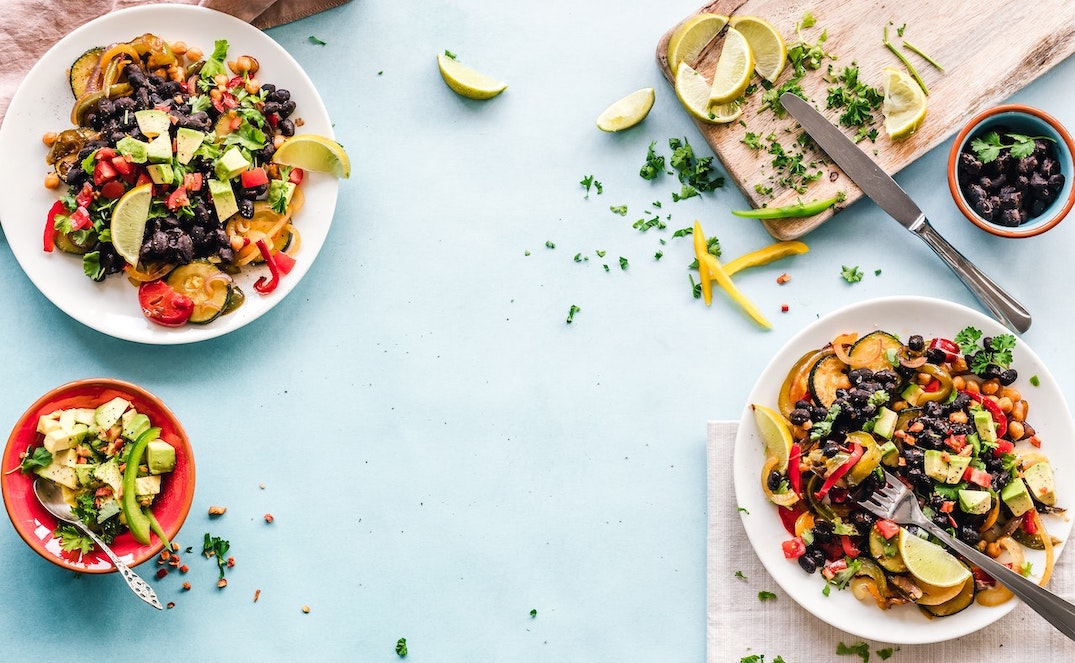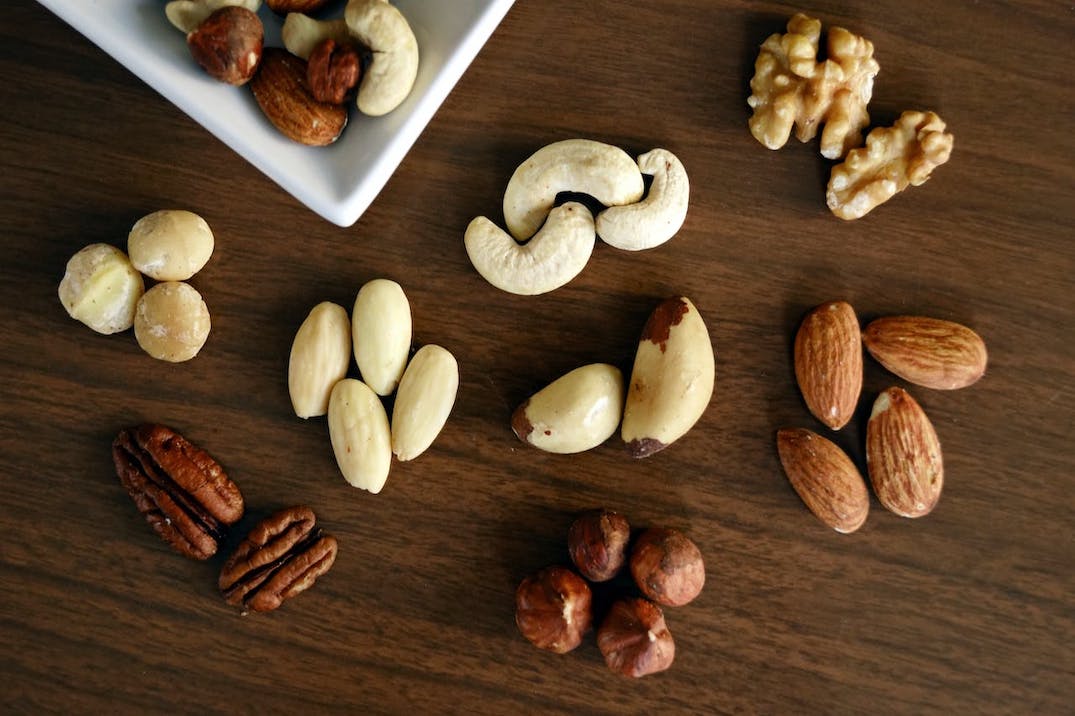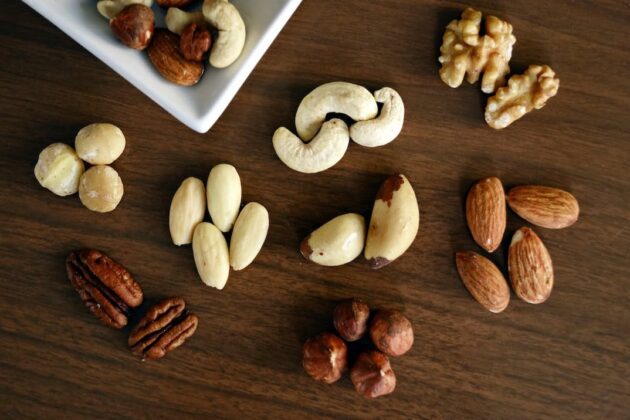How Many Grams of Fat Should I Eat Per Day to Lose Weight?
Many think they need to eliminate fat in their diet to lose weight, but fats can actually be a helpful tool if chosen wisely.
Fats have gotten a bad rap over the years. While they contain more calories per gram compared to carbs and protein, the likely reason you’re gaining weight is the type of fat you’re choosing and how many calories you’re eating overall.
Balance is essential, especially with our diet. Instead of cutting out fats, it’s important to consume them in quality sources and appropriate amounts. For example, the Dietary Reference Intake (DRI) suggests adults aim to consume between 45% – 65% of their total calories from carbohydrates, 20% – 35% from fats, and 10% – 35% from proteins.
This means that someone who consumes a 2,000-calorie diet should be eating between 44 – 78 grams of fat, 225 – 325 grams of carbs, and 50 – 175 grams of protein. Your intake of each macronutrient will depend on your overall calorie intake, preferences, and personal needs, which is why there is a range for each nutrient.
For those looking to lose weight, it’s important to match your goals with the appropriate calorie range, which is going to look different for each individual. This doesn’t mean you need to reduce calories from fats, however. Fats contain more calories per gram than protein and carbs, so you may naturally shy away from higher-fat foods during this time.
There are different types of fats, some of which have a variety of health benefits including feeling more full which can help in weight loss. You want to limit other types of fats that may increase your risk of developing certain chronic conditions if over-consumed.
So which types of fats should we be eating and how many grams? Let’s dive in.
How much fat you should eat if you want to lose weight
How much fat you should be consuming while on a weight loss journey will vary depending on your calorie goal.
For example, someone who is consuming 1,500 calories per day will have a different goal for fat compared to someone who is consuming 2,500 calories per day. So how do we calculate our calorie goals?
Determining your calorie goals for weight loss can be tricky for most people. The amount you should be eating is determined by a variety of factors including age, gender, height, weight, and activity level. There is no one-size-fits-all calorie recommendation during weight loss.
The best way to get accurate calorie recommendations outside of meeting with a Registered Dietitian, is to use an online calorie calculator tool. Look at calculators that use the Mifflin-St Jeor equation as this is linked with the most accurate estimations.
When given your specific calorie range you want to include a deficit of no more than 500 calories to help with weight loss.
Once you have your specific calorie target, with your deficit included, you can determine your recommended fat intake with a simple calculation.
Fat contains 9 calories per gram. If you are aiming to consume no more than 1500 calories per day and you want to eat between 20% – 35% of your calories from fats, the calculation looks like this:
20% of fat calculation
1500 calories × 20% = 300 calories
300 calories ÷ 9 calories per gram = 33 grams of fat
35% of fat calculation
1500 calories × 35% = 525 calories
525 calories ÷ 9 calories per gram = 58 grams
To comply with the DRI for fats during weight loss you would want to consume between 33 – 58 grams per day.
It’s important to avoid restricting fats too much as this can result in an essential fatty acid deficiency. Fats are an essential macronutrient and should not be cut out completely in the name of weight loss as this can have negative health implications.

Reach your weight loss goals faster with support from a Registered Dietitian
90% of Zaya Care patients pay $0 for dietitian visits
Ideal fat intake on low-fat diets
Low-fat diets can be an effective form of weight loss as it helps to reduce calorie intake significantly, however, very low-fat diets can result in nutrient deficiencies and are not recommended.
Instead, aim for the low end of the DRI for fat with an emphasis on monounsaturated and polyunsaturated sources.
If you want to limit fat as a strategy to reduce calorie intake, be sure to at least get a minimum of 20% of your total calories from fats to avoid missing out on essential nutrients.
If using the reference above, someone who is consuming 1,500 calories per day during weight loss should be getting a minimum of 33 grams of fat.
A low-fat diet with primarily monounsaturated and polyunsaturated fat sources could look like this:
- 2 teaspoons of olive oil (9 grams)
- 2 tablespoons of peanut butter (16 grams)
- ½ of an avocado (11 grams)
Ideal fat intake on moderate-fat diets
While a low-fat diet can help reduce calorie intake throughout the day, a moderate to high-fat diet can help improve satiety (the feeling of fullness).
Again, it’s important to choose high-quality sources such as monounsaturated and polyunsaturated fats compared to saturated fats, particularly those that are found in highly processed food items.
Monounsaturated and polyunsaturated fats are associated with many health benefits and improvements in satiety compared to those in heavily processed foods.
A moderate-fat diet will be somewhere between 20% and 35% of your total calorie intake, such as roughly 27%. If using the same example of 1,500 calories per day, on a moderate-fat diet this will equal roughly 45 grams.
A medium-fat diet with primarily monounsaturated and polyunsaturated fat sources could look like this:
- 2 teaspoons of olive oil (9 grams)
- 2 tablespoons of peanut butter (16 grams)
- ½ of an avocado (11 grams)
- 1 ounce of cheese (9 grams)
Ideal fat intake on high-fat diets
High-fat diets during weight loss may be beneficial in curbing hunger and keeping you in line with your calorie ranges. Some studies have found that a balanced high-fat diet may be useful in improving body composition, inflammation, and cardiovascular health in some populations compared to low-fat diets.
A high-fat diet will keep you at the high end of the DRI for fat, which is 35% of your total calories. If using the same example of 1,500 calories per day, a high-fat diet will equal 58 grams of fat.
A high-fat diet with primarily monounsaturated and polyunsaturated fat sources could look like this:
- 1 tablespoon of olive oil (14 grams)
- 2 tablespoons of peanut butter (16 grams)
- ½ of an avocado (11 grams)
- 1 ounce of cheese (9 grams)
- 2 whole eggs (10 grams)

Reach your weight loss goals faster with support from a Registered Dietitian
90% of Zaya Care patients pay $0 for dietitian visits
Why it’s important to include fat in your diet
Fats are an essential macronutrient for health. They perform a variety of functions for the body, including providing energy, absorbing fat-soluble nutrients such as vitamins A, D, E, and K, and producing some hormones. Fat also helps with satiety and flavor during meals to make them more enjoyable and satisfying.
Additionally, fats are a source of essential fatty acids, which our body is unable to produce on its own. If we do not obtain these valuable fats from our diet we can develop an essential fatty acid deficiency (EFAD) which can have severe health consequences. It can also result in fat-soluble vitamin deficiencies as fats are needed to help absorb these nutrients.
Fats are needed to support the functioning of your cells as well as provide protection to your vital organs. Fats are also responsible for helping to regulate temperature. This means they are necessary to help keep you warm.
Although fats have a bad reputation for their excessive presence in many processed food items, they should not be cut from your diet. Fats are valuable for many different purposes and we need them not only to survive but to thrive.
Reviewing types of fat & how much of each you should eat
Fats can be categorized into three different types: saturated, unsaturated, and trans fats. These different fats vary in their sources and potential benefits. This is because they carry different chemical structures that act differently in the body.
Saturated Fats
All fats contain carbon, hydrogen, and oxygen molecules in their chemical structure. Saturated fats are named because they are saturated with hydrogen molecules. Because of this, they only contain single bonds between carbon molecules.
This saturation of hydrogen causes these types of fats to be solid at room temperature. Saturated fats are typically found in animal products but can be in some plant-based foods such as coconut oil.
It’s recommended to limit saturated fats in the diet as some researchers believe high amounts can increase the risk of developing cardiovascular conditions—though the evidence on this is still inconclusive.
According to the 2015-2020 Dietary Guidelines for Americans, saturated fats should be limited to no more than 10% of your total calorie intake. The American Heart Association recommends between 5% – 6% of your total calorie intake.
This means if you consume a 2,000-calorie diet, you should be eating no more than 22 grams of saturated fat per day to be under 10% or 13 grams to be under 6%.
Examples of foods that contain saturated fats include:
- Butter
- Coconut oil
- Cheese
- Whole milk
- Meat
Trans Fats
Trans fats are a type of saturated fat that can be either naturally occurring in small amounts or artificially made. Naturally occurring trans fats are typically found in animal products and are not as detrimental to human health as artificially made trans fats.
Artificial trans fats are made by adding hydrogen to liquid vegetable oils to make them solid at room temperature and can be listed on food labels as partially hydrogenated oils. Many research studies found these types of fats to be harmful to human health so much so that the Food and Drug Administration banned the use of trans fats in foods in 2018.
Previous to their ban, trans fats could be found in foods such as:
- Fried foods
- Baked goods
- Packaged snack foods
- Frozen meals such as pizzas
- Margarine
Unsaturated Fats
Unsaturated fats are missing a few hydrogen atoms, which makes their structure “unsaturated.” Because these fats aren’t fully saturated with hydrogen atoms, there’s space for a double or triple bond in their structure compared to saturated fats which contain only single bonds.
Because of this structure, unsaturated fats are liquid at room temperature. They are mainly composed of plant compounds versus animal compounds and come in two different types: monounsaturated and polyunsaturated (depending on whether it has one double bond or more).
Both monounsaturated and polyunsaturated fats are associated with a variety of health benefits including reducing cholesterol levels and lowering the risk of developing heart disease or stroke.
While there are no formal recommendations for unsaturated fat intake, it’s encouraged to choose more of these types of fats compared to saturated.
There are recommendations for specific unsaturated fats, such as omega-3s. The 2015-2020 Dietary Guidelines for Americans recommends adults aim to get in at least 450 – 500 milligrams of this type of fat each day, particularly from fatty fish.
- Monounsaturated Fats – Examples of good sources of monounsaturated fats include olive oil, avocados, nuts, nut butter, and seeds.
- Polyunsaturated Fats – Good sources include sunflower and soybean oil, canola oil, walnuts, flaxseeds, and fish.
Examples of healthy fats to include in your diet
Now that we know a little bit more about the different types of fats, how they affect our health, and how much we need, it’s time to put them into practice.
Based on the information above, we know a little bit about what sources of fats will benefit us the most, and now we need to figure out how to include them in our diet.
Below are some healthy fat ideas to help give you a head start.
- Olive oil – Olive oil is rich in monounsaturated fatty acids and is incredibly versatile and easy to use in cooking. It is also loaded with antioxidants and may protect against heart disease.
- Avocado – If you haven’t jumped on the avocado toast bandwagon, now may be a good time. Avocados are loaded with beneficial monounsaturated fats as well as a large list of other essential nutrients such as vitamins, minerals, antioxidants, and fiber.
- Salmon – Salmon, as well as other forms of fatty fish such as mackerel, are a rich source of omega-3 fatty acids as well as protein. These fats are essential for our heart and brain health and are best obtained from seafood. You can easily meet your omega-3 needs by consuming fatty fish at least twice per week.
- Dairy – Dairy products—such as cheese, yogurt, and milk—are a good source of fat and are easy to incorporate into a variety of meals and snacks. While these sources contain saturated fats, many research studies found that diets that included these foods in moderate amounts were at a decreased risk of developing heart disease.
- Nuts and seeds – Nuts and seeds can be a great source of both monounsaturated and polyunsaturated fats along with fiber. They are easy to add to meals or snacks and will keep you full and satisfied between meals. Learn more about the best nuts for weight loss here.
How many calories are in each gram of fat
Fat contains 9 calories per gram while protein and carbs contain 4 calories per gram.
Fats have received a bad reputation in part because of their high-calorie content. Fats contain more calories per gram compared to carbs and protein so it’s a lot easier to go over your calorie recommendation if you are consuming a high-fat diet.
Why you should consider working with a dietitian if you’re trying to lose weight
While there are a lot of useful tools out there to help individuals lose weight and make better lifestyle habits, it can also be very confusing.
Unfortunately, there is a lot of conflicting information that circulates in the media which can make losing weight feel even more frustrating. It can also lead individuals down the wrong path toward potential health concerns.
If you feel like you’re constantly yo-yo-ing with your weight and struggle to make sustainable lifestyle changes to reach your goals, it may be time to consider working with a Registered Dietitian (RD). RDs are credentialed practitioner who specializes in nutrition and can help you lose weight healthily.
RDs can provide you with accurate and personalized information to help you meet your goals without all the uncertainty. They can provide you with tailored recommendations for calories and macronutrients, such as fat, so that you can feel confident during your weight loss journey. They can even teach you how to meal prep for weight loss to give yourself the best chance at losing weight (while also saving you time)!
Here at Zaya Care, we’re dedicated to helping people find dietitians based on their preferences, needs, and insurance.
When you request an appointment with one of our Registered Dietitians, we’ll check your insurance so you know exactly how much you’ll have to pay, if anything at all.
It’s worth noting that 90% of Zaya Care patients pay $0 for nutrition care with a registered dietitian as we are in-network with many major carriers.

Reach your weight loss goals faster with support from a Registered Dietitian
90% of Zaya Care patients pay $0 for dietitian visits
Many think they need to eliminate fat in their diet to lose weight, but fats can actually be a helpful tool if chosen wisely.
Fats have gotten a bad rap over the years. While they contain more calories per gram compared to carbs and protein, the likely reason you’re gaining weight is the type of fat you’re choosing and how many calories you’re eating overall.
Balance is essential, especially with our diet. Instead of cutting out fats, it’s important to consume them in quality sources and appropriate amounts. For example, the Dietary Reference Intake (DRI) suggests adults aim to consume between 45% – 65% of their total calories from carbohydrates, 20% – 35% from fats, and 10% – 35% from proteins.
This means that someone who consumes a 2,000-calorie diet should be eating between 44 – 78 grams of fat, 225 – 325 grams of carbs, and 50 – 175 grams of protein. Your intake of each macronutrient will depend on your overall calorie intake, preferences, and personal needs, which is why there is a range for each nutrient.
For those looking to lose weight, it’s important to match your goals with the appropriate calorie range, which is going to look different for each individual. This doesn’t mean you need to reduce calories from fats, however. Fats contain more calories per gram than protein and carbs, so you may naturally shy away from higher-fat foods during this time.
There are different types of fats, some of which have a variety of health benefits including feeling more full which can help in weight loss. You want to limit other types of fats that may increase your risk of developing certain chronic conditions if over-consumed.
So which types of fats should we be eating and how many grams? Let’s dive in.
How much fat you should eat if you want to lose weight
How much fat you should be consuming while on a weight loss journey will vary depending on your calorie goal.
For example, someone who is consuming 1,500 calories per day will have a different goal for fat compared to someone who is consuming 2,500 calories per day. So how do we calculate our calorie goals?
Determining your calorie goals for weight loss can be tricky for most people. The amount you should be eating is determined by a variety of factors including age, gender, height, weight, and activity level. There is no one-size-fits-all calorie recommendation during weight loss.
The best way to get accurate calorie recommendations outside of meeting with a Registered Dietitian, is to use an online calorie calculator tool. Look at calculators that use the Mifflin-St Jeor equation as this is linked with the most accurate estimations.
When given your specific calorie range you want to include a deficit of no more than 500 calories to help with weight loss.
Once you have your specific calorie target, with your deficit included, you can determine your recommended fat intake with a simple calculation.
Fat contains 9 calories per gram. If you are aiming to consume no more than 1500 calories per day and you want to eat between 20% – 35% of your calories from fats, the calculation looks like this:
20% of fat calculation
1500 calories × 20% = 300 calories
300 calories ÷ 9 calories per gram = 33 grams of fat
35% of fat calculation
1500 calories × 35% = 525 calories
525 calories ÷ 9 calories per gram = 58 grams
To comply with the DRI for fats during weight loss you would want to consume between 33 – 58 grams per day.
It’s important to avoid restricting fats too much as this can result in an essential fatty acid deficiency. Fats are an essential macronutrient and should not be cut out completely in the name of weight loss as this can have negative health implications.

Reach your weight loss goals faster with support from a Registered Dietitian
90% of Zaya Care patients pay $0 for dietitian visits
Ideal fat intake on low-fat diets
Low-fat diets can be an effective form of weight loss as it helps to reduce calorie intake significantly, however, very low-fat diets can result in nutrient deficiencies and are not recommended.
Instead, aim for the low end of the DRI for fat with an emphasis on monounsaturated and polyunsaturated sources.
If you want to limit fat as a strategy to reduce calorie intake, be sure to at least get a minimum of 20% of your total calories from fats to avoid missing out on essential nutrients.
If using the reference above, someone who is consuming 1,500 calories per day during weight loss should be getting a minimum of 33 grams of fat.
A low-fat diet with primarily monounsaturated and polyunsaturated fat sources could look like this:
- 2 teaspoons of olive oil (9 grams)
- 2 tablespoons of peanut butter (16 grams)
- ½ of an avocado (11 grams)
Ideal fat intake on moderate-fat diets
While a low-fat diet can help reduce calorie intake throughout the day, a moderate to high-fat diet can help improve satiety (the feeling of fullness).
Again, it’s important to choose high-quality sources such as monounsaturated and polyunsaturated fats compared to saturated fats, particularly those that are found in highly processed food items.
Monounsaturated and polyunsaturated fats are associated with many health benefits and improvements in satiety compared to those in heavily processed foods.
A moderate-fat diet will be somewhere between 20% and 35% of your total calorie intake, such as roughly 27%. If using the same example of 1,500 calories per day, on a moderate-fat diet this will equal roughly 45 grams.
A medium-fat diet with primarily monounsaturated and polyunsaturated fat sources could look like this:
- 2 teaspoons of olive oil (9 grams)
- 2 tablespoons of peanut butter (16 grams)
- ½ of an avocado (11 grams)
- 1 ounce of cheese (9 grams)
Ideal fat intake on high-fat diets
High-fat diets during weight loss may be beneficial in curbing hunger and keeping you in line with your calorie ranges. Some studies have found that a balanced high-fat diet may be useful in improving body composition, inflammation, and cardiovascular health in some populations compared to low-fat diets.
A high-fat diet will keep you at the high end of the DRI for fat, which is 35% of your total calories. If using the same example of 1,500 calories per day, a high-fat diet will equal 58 grams of fat.
A high-fat diet with primarily monounsaturated and polyunsaturated fat sources could look like this:
- 1 tablespoon of olive oil (14 grams)
- 2 tablespoons of peanut butter (16 grams)
- ½ of an avocado (11 grams)
- 1 ounce of cheese (9 grams)
- 2 whole eggs (10 grams)

Reach your weight loss goals faster with support from a Registered Dietitian
90% of Zaya Care patients pay $0 for dietitian visits
Why it’s important to include fat in your diet
Fats are an essential macronutrient for health. They perform a variety of functions for the body, including providing energy, absorbing fat-soluble nutrients such as vitamins A, D, E, and K, and producing some hormones. Fat also helps with satiety and flavor during meals to make them more enjoyable and satisfying.
Additionally, fats are a source of essential fatty acids, which our body is unable to produce on its own. If we do not obtain these valuable fats from our diet we can develop an essential fatty acid deficiency (EFAD) which can have severe health consequences. It can also result in fat-soluble vitamin deficiencies as fats are needed to help absorb these nutrients.
Fats are needed to support the functioning of your cells as well as provide protection to your vital organs. Fats are also responsible for helping to regulate temperature. This means they are necessary to help keep you warm.
Although fats have a bad reputation for their excessive presence in many processed food items, they should not be cut from your diet. Fats are valuable for many different purposes and we need them not only to survive but to thrive.
Reviewing types of fat & how much of each you should eat
Fats can be categorized into three different types: saturated, unsaturated, and trans fats. These different fats vary in their sources and potential benefits. This is because they carry different chemical structures that act differently in the body.
Saturated Fats
All fats contain carbon, hydrogen, and oxygen molecules in their chemical structure. Saturated fats are named because they are saturated with hydrogen molecules. Because of this, they only contain single bonds between carbon molecules.
This saturation of hydrogen causes these types of fats to be solid at room temperature. Saturated fats are typically found in animal products but can be in some plant-based foods such as coconut oil.
It’s recommended to limit saturated fats in the diet as some researchers believe high amounts can increase the risk of developing cardiovascular conditions—though the evidence on this is still inconclusive.
According to the 2015-2020 Dietary Guidelines for Americans, saturated fats should be limited to no more than 10% of your total calorie intake. The American Heart Association recommends between 5% – 6% of your total calorie intake.
This means if you consume a 2,000-calorie diet, you should be eating no more than 22 grams of saturated fat per day to be under 10% or 13 grams to be under 6%.
Examples of foods that contain saturated fats include:
- Butter
- Coconut oil
- Cheese
- Whole milk
- Meat
Trans Fats
Trans fats are a type of saturated fat that can be either naturally occurring in small amounts or artificially made. Naturally occurring trans fats are typically found in animal products and are not as detrimental to human health as artificially made trans fats.
Artificial trans fats are made by adding hydrogen to liquid vegetable oils to make them solid at room temperature and can be listed on food labels as partially hydrogenated oils. Many research studies found these types of fats to be harmful to human health so much so that the Food and Drug Administration banned the use of trans fats in foods in 2018.
Previous to their ban, trans fats could be found in foods such as:
- Fried foods
- Baked goods
- Packaged snack foods
- Frozen meals such as pizzas
- Margarine
Unsaturated Fats
Unsaturated fats are missing a few hydrogen atoms, which makes their structure “unsaturated.” Because these fats aren’t fully saturated with hydrogen atoms, there’s space for a double or triple bond in their structure compared to saturated fats which contain only single bonds.
Because of this structure, unsaturated fats are liquid at room temperature. They are mainly composed of plant compounds versus animal compounds and come in two different types: monounsaturated and polyunsaturated (depending on whether it has one double bond or more).
Both monounsaturated and polyunsaturated fats are associated with a variety of health benefits including reducing cholesterol levels and lowering the risk of developing heart disease or stroke.
While there are no formal recommendations for unsaturated fat intake, it’s encouraged to choose more of these types of fats compared to saturated.
There are recommendations for specific unsaturated fats, such as omega-3s. The 2015-2020 Dietary Guidelines for Americans recommends adults aim to get in at least 450 – 500 milligrams of this type of fat each day, particularly from fatty fish.
- Monounsaturated Fats – Examples of good sources of monounsaturated fats include olive oil, avocados, nuts, nut butter, and seeds.
- Polyunsaturated Fats – Good sources include sunflower and soybean oil, canola oil, walnuts, flaxseeds, and fish.
Examples of healthy fats to include in your diet
Now that we know a little bit more about the different types of fats, how they affect our health, and how much we need, it’s time to put them into practice.
Based on the information above, we know a little bit about what sources of fats will benefit us the most, and now we need to figure out how to include them in our diet.
Below are some healthy fat ideas to help give you a head start.
- Olive oil – Olive oil is rich in monounsaturated fatty acids and is incredibly versatile and easy to use in cooking. It is also loaded with antioxidants and may protect against heart disease.
- Avocado – If you haven’t jumped on the avocado toast bandwagon, now may be a good time. Avocados are loaded with beneficial monounsaturated fats as well as a large list of other essential nutrients such as vitamins, minerals, antioxidants, and fiber.
- Salmon – Salmon, as well as other forms of fatty fish such as mackerel, are a rich source of omega-3 fatty acids as well as protein. These fats are essential for our heart and brain health and are best obtained from seafood. You can easily meet your omega-3 needs by consuming fatty fish at least twice per week.
- Dairy – Dairy products—such as cheese, yogurt, and milk—are a good source of fat and are easy to incorporate into a variety of meals and snacks. While these sources contain saturated fats, many research studies found that diets that included these foods in moderate amounts were at a decreased risk of developing heart disease.
- Nuts and seeds – Nuts and seeds can be a great source of both monounsaturated and polyunsaturated fats along with fiber. They are easy to add to meals or snacks and will keep you full and satisfied between meals. Learn more about the best nuts for weight loss here.
How many calories are in each gram of fat
Fat contains 9 calories per gram while protein and carbs contain 4 calories per gram.
Fats have received a bad reputation in part because of their high-calorie content. Fats contain more calories per gram compared to carbs and protein so it’s a lot easier to go over your calorie recommendation if you are consuming a high-fat diet.
Why you should consider working with a dietitian if you’re trying to lose weight
While there are a lot of useful tools out there to help individuals lose weight and make better lifestyle habits, it can also be very confusing.
Unfortunately, there is a lot of conflicting information that circulates in the media which can make losing weight feel even more frustrating. It can also lead individuals down the wrong path toward potential health concerns.
If you feel like you’re constantly yo-yo-ing with your weight and struggle to make sustainable lifestyle changes to reach your goals, it may be time to consider working with a Registered Dietitian (RD). RDs are credentialed practitioner who specializes in nutrition and can help you lose weight healthily.
RDs can provide you with accurate and personalized information to help you meet your goals without all the uncertainty. They can provide you with tailored recommendations for calories and macronutrients, such as fat, so that you can feel confident during your weight loss journey. They can even teach you how to meal prep for weight loss to give yourself the best chance at losing weight (while also saving you time)!
Here at Zaya Care, we’re dedicated to helping people find dietitians based on their preferences, needs, and insurance.
When you request an appointment with one of our Registered Dietitians, we’ll check your insurance so you know exactly how much you’ll have to pay, if anything at all.
It’s worth noting that 90% of Zaya Care patients pay $0 for nutrition care with a registered dietitian as we are in-network with many major carriers.

Reach your weight loss goals faster with support from a Registered Dietitian
90% of Zaya Care patients pay $0 for dietitian visits
















